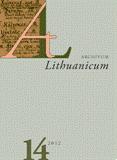Lietuvių kalbos balsių abėcėlės tvarka ir netvarka: istorija ir nūdiena
Order and disorder of the vowels in the Lithuanian alphabet: A historical look at the creation of Lithuanian alphabetical order
Author(s): Giedrius Subačius Subject(s): Theoretical Linguistics, Lexis, Historical Linguistics, Baltic Languages, 19th Century
Published by: Lietuvių Kalbos Institutas
Keywords: Lithuanian alphabet; Vowels; Kristijonas Milkus; 19th century;
Summary/Abstract: In the first half of the 19th century the diacritical letters marking vowel sounds were rarely employed in word initial position in the head word in a Lithuanian dictionary, and if occurring, their appearance was quite unsystematic. The authors in Lithuania Major did not use the diacritical <Ė> at all, although it was present in the dictionary of Kristijonas Milkus (1800) from Lithuania Minor. Dominykas Sutkevičius wrote the diacritical <Ą> interchangeably with the plain <A> (1835). Diacritical <Į> (in the shape of <Ɨ>) was included in the <I> section both by Milkus and Sutkevičius. Ambraziejus Pabrėža alone separated <Ą> and <Ę> under individual headings (in accordance with the alphabetical order of Polish; 1834). Because of the traditional lack of a distinction between the capital letters <I> and <J>, the words containing sounds [i] and [j] in word initial position most often were merged into a single list, and the sign <I> was used to represent both of them (Milkus, Pabrėža, Sutkevičius, and the anonymous author of an Eastern Highland Dictionary). Stanevičius alone (1823) separated sounds [i] and [j] and formed two separate lists for the two distinct letters <I> and <J>.
Journal: Archivum Lithuanicum
- Issue Year: 2012
- Issue No: 14
- Page Range: 155-190
- Page Count: 36
- Language: Lithuanian

